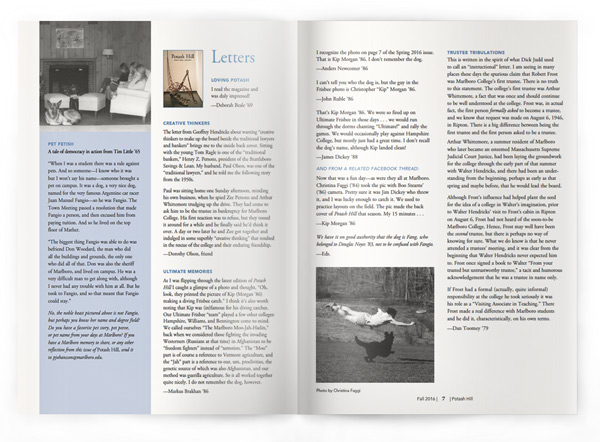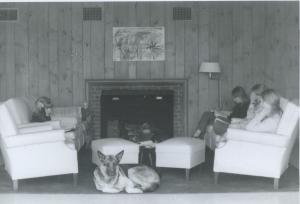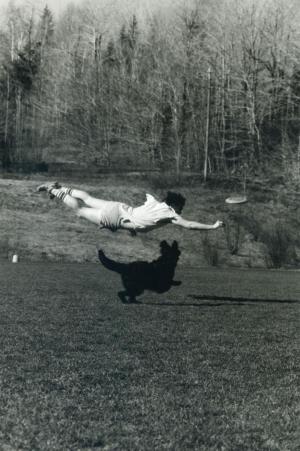Letters

Pet Fetish
A tale of democracy in action from Tim Little ’65
 “When I was a student there was a rule against pets. And so someone—I know who it was but I won’t say his name—someone brought a pet on campus. It was a dog, a very nice dog, named for the very famous Argentine car racer Juan Manuel Fangio—so he was Fangio. The Town Meeting passed a resolution that made Fangio a person, and then excused him from paying tuition. And so he lived on the top floor of Mather.
“When I was a student there was a rule against pets. And so someone—I know who it was but I won’t say his name—someone brought a pet on campus. It was a dog, a very nice dog, named for the very famous Argentine car racer Juan Manuel Fangio—so he was Fangio. The Town Meeting passed a resolution that made Fangio a person, and then excused him from paying tuition. And so he lived on the top floor of Mather.
“The biggest thing Fangio was able to do was befriend Don Woodard, the man who did all the buildings and grounds, the only one who did all of that. Don was also the sheriff of Marlboro, and lived on campus. He was a very difficult man to get along with, although I never had any trouble with him at all. But he took to Fangio, and so that meant that Fangio could stay.”
No, the noble beast pictured (right) is not Fangio, but perhaps you know her name and degree field? Do you have a favorite pet story, pet peeve, or pet name from your days at Marlboro? If you have a Marlboro memory to share, or any other reflection from this issue of Potash Hill, send it to pjohansson@marlboro.edu.
Loving Potash
I read the magazine and was duly impressed!
—Deborah Beale ’69
Creative Thinkers
The letter from Geoffrey Hendricks about wanting “creative thinkers to make up the board beside the traditional lawyers and bankers” brings me to the inside back cover. Sitting with the young Tom Ragle is one of the “traditional bankers,” Henry Z. Persons, president of the Brattleboro Savings & Loan. My husband, Paul Olson, was one of the “traditional lawyers,” and he told me the following story from the 1950s.
Paul was sitting home one Sunday afternoon, minding his own business, when he spied Zee Persons and Arthur Whittemore trudging up the drive. They had come to ask him to be the trustee in bankruptcy for Marlboro College. His first reaction was to refuse, but they tossed it around for a while and he finally said he’d think it over. A day or two later he and Zee got together and indulged in some superbly “creative thinking” that resulted in the rescue of the college and their enduring friendship.
—Dorothy Olson, friend
Ultimate Memories

As I was flipping through the latest edition of Potash Hill I caught a glimpse of a photo and thought, “Oh, look, they printed the picture of Kip (Morgan ’86) making a diving Frisbee catch.” I think it’s also worth noting that Kip was (in)famous for his diving catches. Our Ultimate Frisbee “team” played a few other colleges: Hampshire, Williams, and Bennington come to mind. We called ourselves “The Marlboro Moo-Jah-Hadin,” back when we considered those fighting the invading Westerners (Russians at that time) in Afghanistan to be “freedom fighters” instead of “terrorists.” The “Moo” part is of course a reference to Vermont agriculture, and the “Jah” part is a reference to our, um, proclivities, the genetic source of which was also Afghanistan, and our method was guerilla agriculture. So it all worked together quite nicely. I do not remember the dog, however.
—Markus Brakhan ’86
I recognize the photo on page 7 of the Spring 2016 issue. That is Kip Morgan ’86. I don’t remember the dog.
—Anders Newcomer ’86
I can’t tell you who the dog is, but the guy in the Frisbee photo is Christopher “Kip” Morgan ’86.
—John Ruble ’86
That’s Kip Morgan ’86. We were so fired up on Ultimate Frisbee in those days . . . we would run through the dorms chanting “Ultimate!” and rally the games. We would occasionally play against Hampshire College, but mostly just had a great time. I don’t recall the dog’s name, although Kip landed clean!
—James Dickey ’88
And from a related facebook thread
Now that was a fun day—as were they all at Marlboro. Christina Faggi (’84) took the pic with Boo Stearns’ (’86) camera. Pretty sure it was Jim Dickey who threw it, and I was lucky enough to catch it. We used to practice layouts on the field. The pic made the back cover of Potash Hill that season. My 15 minutes . . .
—Kip Morgan ’86
We have it on good authority that the dog is Fang, who belonged to Douglas Noyes ’83, not to be confused with Fangio. —Eds.
Trustee Tribulations
This is written in the spirit of what Dick Judd used to call an “instructional” letter. I am seeing in many places these days the spurious claim that Robert Frost was Marlboro College’s first trustee. There is no truth to this statement. The college’s first trustee was
Arthur Whittemore, a fact that was once and should continue to be well understood at the college. Frost was, in actual fact, the first person formally asked to become a trustee, and we know that request was made on August 6, 1946, in Ripton. There is a big difference between being the first trustee and the first person asked to be a trustee. Arthur Whittemore, a summer resident of Marlboro who later became an esteemed Massachusetts Supreme Judicial Court Justice, had been laying the groundwork for the college through the early part of that summer with Walter Hendricks, and there had been an understanding from the beginning, perhaps as early as that spring and maybe before, that he would lead the board.
Although Frost’s influence had helped plant the seed for the idea of a college in Walter’s imagination, prior to Walter Hendricks’ visit to Frost’s cabin in Ripton on August 6, Frost had not heard of the soon-to-be Marlboro College. Hence, Frost may well have been the second trustee, but there is perhaps no way of knowing for sure. What we do know is that he never attended a trustees’ meeting, and it was clear from the beginning that Walter Hendricks never expected him to. Frost once signed a book to Walter “From your trusted but untrustworthy trustee,” a tacit and humorous acknowledgement that he was a trustee in name only.
If Frost had a formal (actually, quite informal) responsibility at the college he took seriously it was his role as a “Visiting Associate in Teaching.” There Frost made a real difference with Marlboro students and he did it, characteristically, on his own terms.
—Dan Toomey ’79
